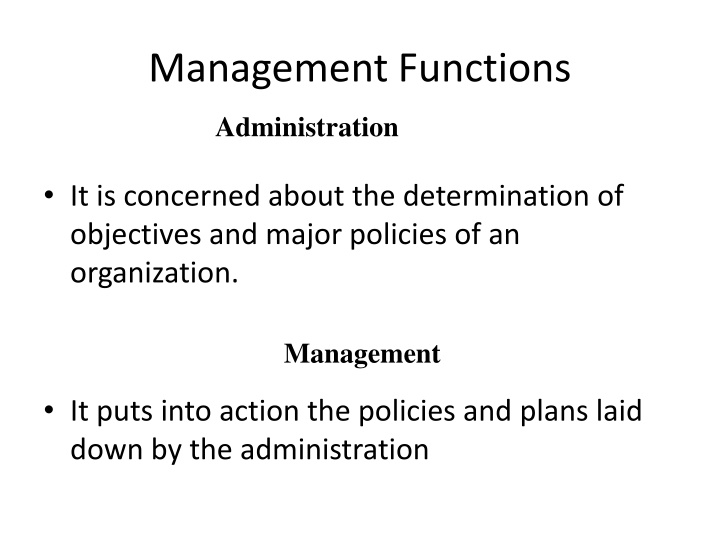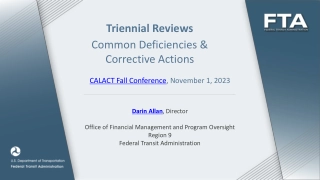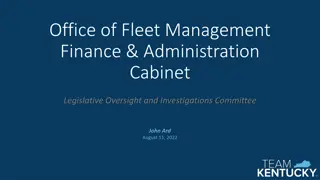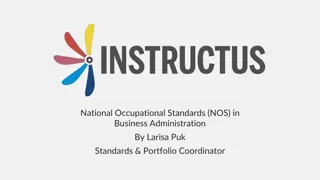Key Differences Between Administration and Management
Administration and management play distinct roles within an organization. While administration sets objectives and policies, management implements them. Learn about their functions, scopes, levels of authority, and differences in the nursing field. Understand the unique responsibilities of administrators and managers in forming vision and executing plans. Explore the nature of work, decision making, and activities involved in each role.
Uploaded on Apr 04, 2025 | 0 Views
Download Presentation

Please find below an Image/Link to download the presentation.
The content on the website is provided AS IS for your information and personal use only. It may not be sold, licensed, or shared on other websites without obtaining consent from the author.If you encounter any issues during the download, it is possible that the publisher has removed the file from their server.
You are allowed to download the files provided on this website for personal or commercial use, subject to the condition that they are used lawfully. All files are the property of their respective owners.
The content on the website is provided AS IS for your information and personal use only. It may not be sold, licensed, or shared on other websites without obtaining consent from the author.
E N D
Presentation Transcript
Management Functions Administration It is concerned about the determination of objectives and major policies of an organization. Management It puts into action the policies and plans laid down by the administration
Type of function It is an executive function. Management It is a determinative function. Administration Scope It takes decisions within the framework set by the administration. Management It takes major decisions of an enterprise as a whole. Administration
Level of authority It is a top-level activity Administration It is a middle level activity. Management Nature of status It is a group of managerial personnel who use their specialized knowledge to fulfill the objectives of an enterprise Management It consists of owners who invest capital in and receive profits from an enterprise Administration
Difference between Administration and Management in Nursing Basis of difference Administration Management It is concerned about the determination of objectives and major policies of an organization. It puts into action the policies and plans laid down by the administration. Nature of work Type of function It is a determinative function. It is an executive function. It takes decisions within the framework set by the administration. Scope It takes major decisions of an enterprise as a whole. Level of authority It is a top-level activity. It is a middle level activity. It is a group of managerial personnel who use their specialized knowledge to fulfill the objectives of an enterprise. It consists of owners who invest capital in and receive profits from an enterprise. Nature of status It is popular with government, military, educational, and religious organizations. Nature of usage It is used in business enterprises. Its decisions are influenced by public opinion, government policies, social, and religious factors. Its decisions are influenced by the values, opinions, and beliefs of the managers. Decision making Motivating and controlling functions are involved in it. Main functions Planning and organizing functions are involved in it. Abilities It needs administrative rather than technical abilities. It requires technical activities.
Difference between Administrator & Manager Definition is the person who is responsible for forming the strategic vision of the organization (top-level of hierarchy). Administrator is the person who is responsible for translating the administration's vision into operating plans and acting in the middle and first-line levels of hierarchy Manager
Activities Administrator Concerned with forming a strategy of the organization Manager Concerned with forming the operation of the unit(s). Events Inside the unit(s) Manager Administrator Inside and outside the organization and how it affect work. Plan long term plans Administrator Manager short term plans
Difference between Administrator & Manager Basis of difference Administrator Manager Administrator is the person who is responsible for forming the strategic vision of the organization (top-level of hierarchy). Manager is the person who is responsible for translating the administration's vision into operating plans and acting in the middle and first-line levels of hierarchy Definition To formulate organizational structure. To direct, supervise personnel working in the formulated organizational structure. Activities Inside and outside the organization and how it affect work. Events Inside the unit (s) Plan long term plans short term plans To formulate organizational structure. To direct, supervise personnel working in the formulated organizational structure. Authority mission, philosophy, goals, and policies governing the organization goals and objectives governing the unit/department Define
Leadership is a process of getting things done through people. Leadership is not a science. Leadership means responsibility. The leader is look to get the job done. Leadership is guiding a person or group toward the best results. It is having sound understanding to determine and ability to articulate visions and goals.
What is the Difference between Leadership and Management? Leadership 1 Based on influence Based on authority Management Management Formally designated position An informal designation 2 Leadership 3 An achieved position An assigned position Leadership Management Dependent and improved by use of effective leadership skills Leadership 4 Independent of management Management Nurse's role in the assigned managerial positions Leadership 5 Part of every nurse's role Management Focusing on people, inspiring and motivating followers, based on personal power Focusing on service, based on position power 6 Management Leadership 7 Acting as a facilitator, and coach Acting as a boss 8 Aimed to change for improvement Aimed to maintain stability
The organizational structure of nursing service department The organizational structure furnishes the formal framework in which the management process takes place. It provides: effective work system network of communications. The organization contains both formal and informal structures.
Nursing department structure Based on: organizational goals philosophy, & objectives Specifies how much: position in the department nursing department is related to hospital departments
Organizational chart It is a diagram shows the different positions and departments, and the relationships among them. It is used to show: The formal organizational relationships. Areas of responsibility. Persons to whom one is accountable. Channels of communication.
Types of organizational charts Vertical charts: It shows high-level management at the top with formal lines of authority down the hierarchy. A left-to-right (horizontal) charts: It shows the high-level management at the left with lower positions to the right.
Functions of Management 1. Planning Function: - function of forecasting and decision making. The planning process : Mission Choice of objectives and guides for decision making Necessary rules for their accomplishment Mechanism to measure the accomplishment
The duration of planning long-term (strategic) short-term (operational) :Strategic plan The organizational plan that includes the development of overall organizational goals and objectives are known as
2. Organizing Function The organizing purpose is To establish a chain of command and a division of labor to accomplish the ends (goals). The organizing process involves: Identification of duties to be performed. Grouping of duties to indicate division arrangements. Assignment of authority.
3. Staffing Function Purpose is to manage activities and adequate personnel to fulfill the organization's objectives. The staffing process Determining workloads or patient care needs. Developing staffing patterns. Developing staffing plan. Personnel management and development.
4. Directing Function Directing process is a continuous and interrelated task of leadership and supervision of personnel towards organizational objectives. The directing process involves: Giving directions and Delegation. Establishing an organizational communication system. Creating a motivating climate and motivation system. Providing supervision, guidance, instruction, and training.
5. Controlling Function Is defined as: The management process that aims at monitoring performance, comparing it with goals, and taking corrective action is known as The controlling process 1. Establishment of standard related to particular course of action. 2. Measuring actual performance against these standards. 3. Reporting the results. 4. Correcting deviations from standard.
Levels of management: Since the organization is a hierarchy, the work of management is divided into three main levels of responsibility. Top-level managers Middle-level First-line level
Nurse Managers' Roles Nurse Managers, at all managerial levels, are accountable for: Nursing practice/ patient care. Managing resources. Development of personnel. Compliance with standards of care. Strategic planning. Collaboration among departments.
Skills are "the abilities developed by managers through knowledge, information & practice". Management Skills can be divided into 3 categories Technical Interpersonal Conceptual
1-Technical Skills Perform a specialised task :e.g. Head nurses have technical skills in assigning, scheduling, etc. Daily activities of most managers will involve the use of some technical skills.
2-Interpersonal Skills Most top managers spend about half their time dealing with other people. they must develop their abilities to motivate & communicate with those around them All managers require sound interpersonal skills
3-Conceptual Skills Ability to see the organization as a whole. This is a necessary skill for strategic decision making























